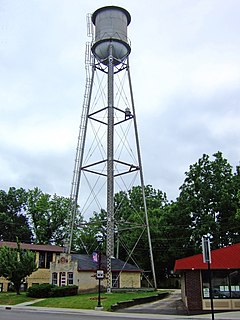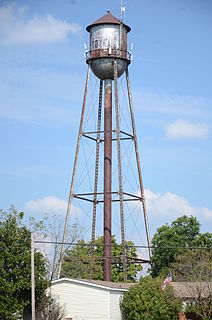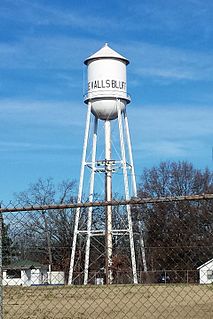
The Cuyuna Iron Range Municipally-Owned Elevated Metal Water Tanks are a group of five water towers within the Cuyuna Range in Crow Wing County, Minnesota. The water tanks, built between 1912 and 1918, were listed on the National Register of Historic Places because they represent the historical period of community planning, public works, and engineering that supported the development of the Cuyuna Range. Their construction was made possible by a favorable property tax arrangement on the iron mines that brought significant revenues to the towns of Crosby, Cuyuna, Deerwood, Ironton, and Trommald. The communities began around 1910, when iron mining started on the Range. The peak of mining employment was around 1920, and it started to decline around 1930. By the 1950s, iron mining was well in decline on the Cuyuna Range. As of 2022, it appears only two of the water tanks survive at their original locations.

Lockesburg Waterworks are a water storage and distribution facility at the junction of Hickory and Azalea Streets in Lockesburg, Arkansas. The facility consists of a water tower and three water storage sheds, of which the tower was built in 1936 with funding assistance from the Public Works Administration, a Depression-era works project. The older shed was built in 1945, and the second was built in 1990. The tower is a metal structure with four legs supported and stabilized by cross bracing, with a metal tank at the top which is sheltered by a conical roof. The oldest shed is a modest square brick structure at the center of the complex, while the 1990 shed is located at the southwest corner of the property.

The Waldo water tower is a historic elevated steel water tower located in Waldo, Arkansas, United States, that is listed on the National Register of Historic Places.

Mackay Estate Water Tower is a historic water tower located in the Incorporated Village of East Hills in Nassau County, on Long Island, in New York, United States. The tower was originally a component of Clarence Mackay's Harbor Hill Estate.

The Oregon Water Tower and Pump House is a metal tower with a brick pump house built in 1899 in Oregon, Wisconsin. It was added to the National Register of Historic Places in 2007.

The Pittsburgh-Des Moines Steel Company, and often referred to as Pitt-Des Moines Steel or PDM was an American steel fabrication company. It operated from 1892 until approximately 2002 when its assets were sold to other companies, including Chicago Bridge & Iron Company. The company began as a builder of steel water tanks and bridges. It also later fabricated the "forked" columns for the World Trade Center in the 1960s, and was the steel fabricator and erector for the Gateway Arch in St. Louis. A number of its works are listed on the National Register of Historic Places.

The Cotter water tower is a historic elevated steel water tower located in Cotter, Arkansas. It was constructed in 1935 by the Pittsburgh-Des Moines Steel Company, as part of the development of the local water supply system by the Public Works Administration. The tower was added to the National Register of Historic Places in 2007, as part of a multiple-property listing that included numerous other PWA-era projects in Arkansas, under the heading “An Ambition to Be Preferred: New Deal Recovery Efforts and Architecture in Arkansas, 1933-1943.”

The Cotton Plant water tower is a historic elevated steel water tower located in Cotton Plant, Arkansas. It was built in 1935 by the Pittsburgh-Des Moines Steel Company in conjunction with the Public Works Administration as part of a project to improve the area's water supply. It was added to the National Register of Historic Places in 2008, as part of a multiple-property listing that included numerous other New Deal-era projects throughout Arkansas.

The Mineral Springs Waterworks is a historic site located in Mineral Springs, Arkansas. It contains a good example of a 1930s-era elevated steel water tower, built in 1936 by the Pittsburgh-Des Moines Steel Company in conjunction with the Public Works Administration as part of a project to improve the town's water supply. The tower was built to store water obtained from a nearby well. It was added to the National Register of Historic Places in 2007, as part of a multiple-property listing that included numerous other New Deal-era projects throughout Arkansas. A new water well was drilled nearby in 1985; however, the original water tower still stands. The Mineral Springs Waterworks remains in operation.

The Monette Water Tower is a historic structure located at the junction of Arkansas Highway 139 and Texie Avenue in Monette, Arkansas. It was built in 1936 by the Chicago Bridge & Iron Company in conjunction with the Public Works Administration as part of a project to improve the area's water supply. The Monette Water Tower is considered a good example of a 1930s-era elevated steel water tank. It was added to the National Register of Historic Places in 2008, as part of a multiple-property listing that included numerous other New Deal-era projects throughout Arkansas.

The Monette Water Tower is a historic elevated steel water tower located in Hartford, Arkansas. It was built in 1936 by the Chicago Bridge & Iron Company in conjunction with the Public Works Administration as part of a project to improve the local water supply. The project was one of 124 similar projects in the state funded by the PWA. It was added to the National Register of Historic Places in 2008, as part of a multiple-property listing that included numerous other New Deal-era projects throughout Arkansas.

The Tyronza Water Tower is a historic elevated steel water tower located in Tyronza, Arkansas. It was built in 1935 by the Chicago Bridge & Iron Company in conjunction with the Public Works Administration as part of a project to improve the local water supply. It was added to the National Register of Historic Places in 2007, as part of a multiple-property listing that included numerous other New Deal-era projects throughout Arkansas. The Tyronza Water Tower is considered an excellent representation of 1930s-era waterworks construction.

The McCrory Waterworks is a historic site located in McCrory, Arkansas. It contains an elevated steel water tower, built in 1936 by the Chicago Bridge & Iron Company in conjunction with the Public Works Administration, which provided $39,497 in aid for the construction of the waterworks, which included the water tower, tank, and water shed. The site was added to the National Register of Historic Places in 2007, as part of a multiple-property listing that included numerous other New Deal-era projects throughout Arkansas.

The De Valls Bluff Waterworks is a historic public water supply facility at Rumbaugh and Hazel Streets in De Valls Bluff, Arkansas. It contains a 1930s-era elevated steel water tower, built in 1936 by the Pittsburgh-Des Moines Steel Company in conjunction with the Public Works Administration as part of a project to improve the local water supply. It was added to the National Register of Historic Places in 2007, as part of a multiple-property listing that included numerous other New Deal-era projects throughout Arkansas. The property also contains several non-contributing buildings, including a shed, aeration chamber and water tank.

The Monroe Water Tower is a historic water tower built in 1889 in Monroe, Wisconsin. It was added to the National Register of Historic Places in 2005.

The Bearden Water Works are a historic public water works facility in Bearden, Arkansas, United States. It is located behind Bearden's city hall, at the corner of North 2nd Street and North Cedar Street, and consists of a water tower, two well houses, and a concrete holding tank. The facility was funded in 1936 by the Public Works Administration (PWA), and is the only PWA-built water works left in the county.

The Keiser Water Tower is a historic waterworks facility at Water and East Main Street in Keiser, Arkansas. It is an open metal structure, several stories high, with a roughly cylindrical tank at the top, and a rising through the center to provide water to the tank. A ladder providing access to the tank is fixed to one of the legs, and there is a circular catwalk with railing around the tank. The structure was built in 1936 with funding from the Public Works Administration, and is one of the few Depression-era structures left in the small community.

The Green Forest Water Tower is a historic water tower, located near the junction of South Springfield and East Second Streets in Green Forest, Arkansas. It consists of a metal supporting structure with four legs and cross bracing, supporting a water tank with a bowl-shaped bottom, with a water pipe in the center of the structure connecting the tank to the water system. The tank was built in 1937 by the Chicago Bridge and Iron Works Company with funding from the Public Works Administration. It is the only known surviving PWA-funded tower in Carroll County.

The Tuckerman Water Tower is a historic waterworks facility at the south end of Front Street in Tuckerman, Arkansas. It is a tall metal structure, with four latticed legs, braced with rods and sloping inward, to support a water tank that is bowl-shaped at the bottom and topped by a conical roof. A pipe traverses the center of the tower for the movement of water to and from the tank. Built in 1935 with funding support from the Depression-era Public Works Administration (PWA), it is the only remaining PWA tower of its type in the county.

The Mountain View Waterworks are a historic public water supply system in Mountain View, Arkansas. The facilities consist of a tower and well house, located at the junction of Gaylor and King Streets. The tower is a metal structure with four legs, reinforced by diagonal latticework members, topped by a water tank with a bowl-shaped bottom and a conical roof. A large pipe connects from the bottom of the tank to the well house, a square fieldstone structure. These facilities were built in 1936–37 with funding from the Public Works Administration, and were still in use at the time of the property's listing on the National Register of Historic Places in 2006.






















